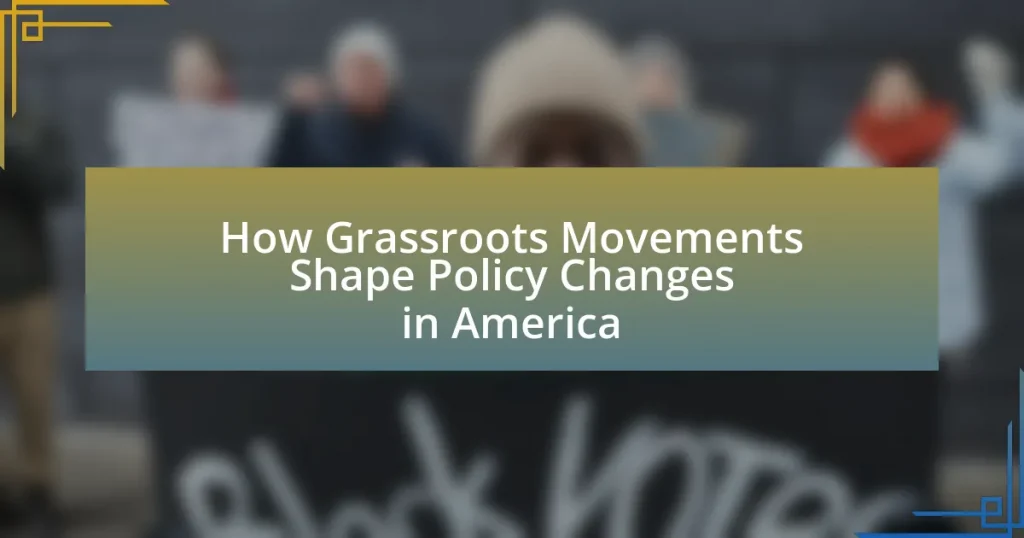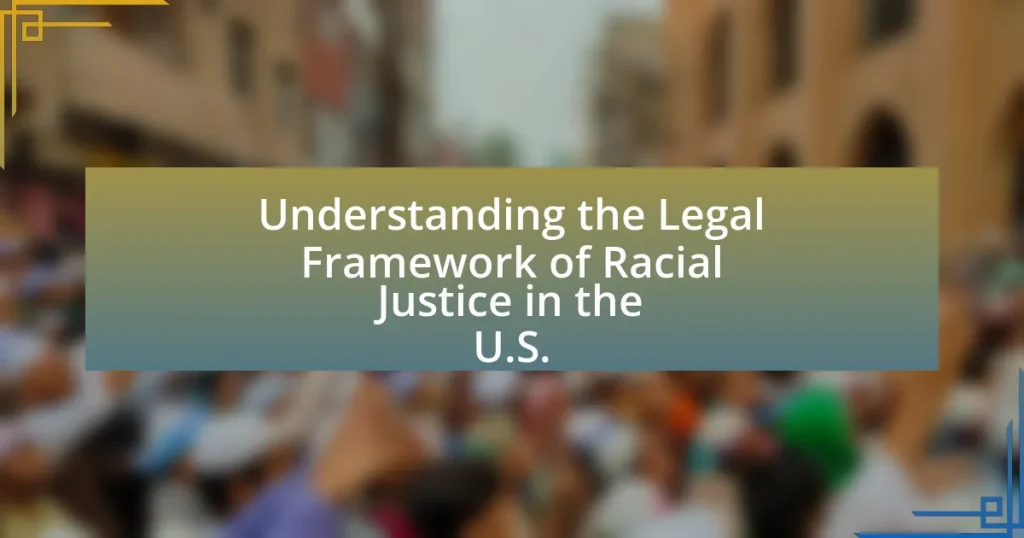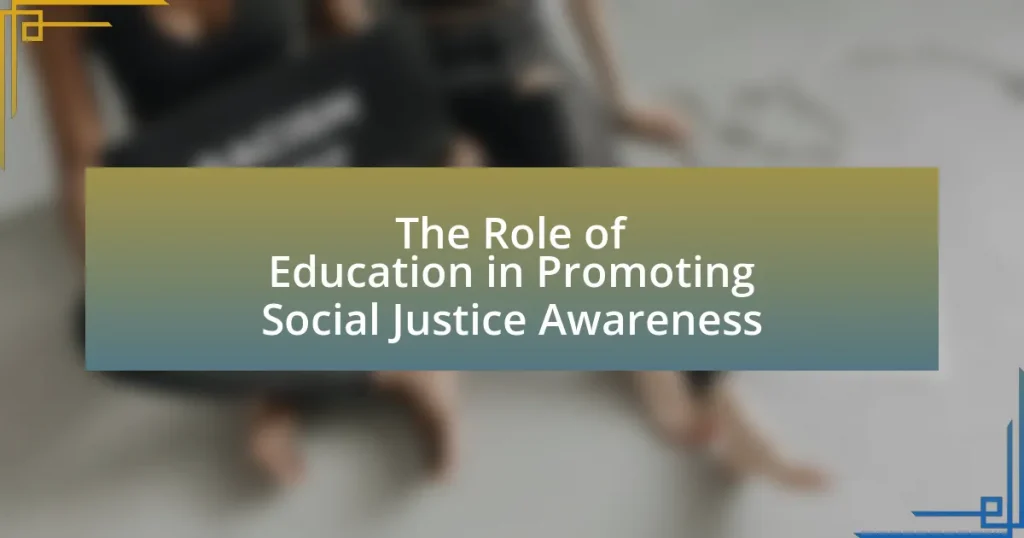Grassroots movements are organized efforts by ordinary individuals aimed at achieving social or political change, particularly at the local level, and play a vital role in shaping policy changes in America. This article explores the emergence of grassroots movements, the social conditions that foster their development, and the influence of community leaders in mobilizing support. It examines the importance of grassroots activism in advocating for policy changes, the strategies employed to engage citizens and lawmakers, and the challenges these movements face, including funding limitations and political opposition. Additionally, the article highlights the characteristics of successful grassroots movements and offers practical steps for individuals to support local initiatives and advocate for policy change.
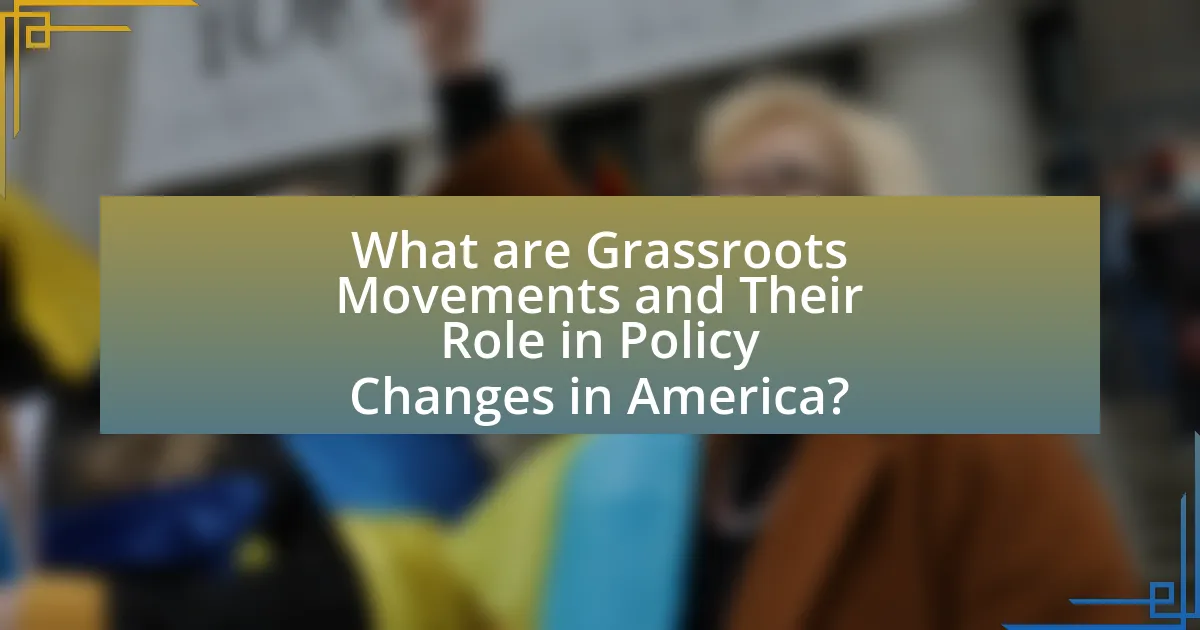
What are Grassroots Movements and Their Role in Policy Changes in America?
Grassroots movements are organized efforts by ordinary people to effect social or political change, often at the local level. These movements play a crucial role in policy changes in America by mobilizing community members, raising awareness about specific issues, and influencing public opinion and lawmakers. For instance, the Civil Rights Movement of the 1960s exemplifies how grassroots activism led to significant legislative changes, including the Civil Rights Act of 1964 and the Voting Rights Act of 1965. Additionally, contemporary movements like Black Lives Matter have demonstrated the power of grassroots organizing in shaping discussions around police reform and racial justice, leading to policy proposals and changes in various jurisdictions.
How do Grassroots Movements emerge in American society?
Grassroots movements in American society emerge primarily through the collective action of individuals who share common interests or grievances. These movements often begin at the local level, driven by community members who mobilize around specific issues such as social justice, environmental concerns, or political reform. For instance, the Civil Rights Movement of the 1960s originated from local activists advocating for racial equality, demonstrating how grassroots efforts can gain momentum and influence national policy. Additionally, the rise of social media has facilitated the rapid organization and dissemination of information, allowing grassroots movements to reach wider audiences and garner support more effectively.
What social conditions foster the development of Grassroots Movements?
Social conditions that foster the development of grassroots movements include widespread social inequality, political disenfranchisement, and community discontent. These conditions create a fertile ground for collective action as marginalized groups seek to address their grievances. For instance, the Civil Rights Movement in the United States emerged in response to systemic racism and economic disparities, highlighting how social injustices can galvanize communities to mobilize for change. Additionally, the rise of digital communication has enabled grassroots organizations to organize more effectively, as seen in movements like Black Lives Matter, which gained momentum through social media platforms. These examples illustrate that social conditions characterized by inequality and discontent are critical in nurturing grassroots movements.
How do community leaders influence the formation of these movements?
Community leaders significantly influence the formation of grassroots movements by mobilizing local populations, providing direction, and fostering a sense of shared purpose. They often serve as trusted figures within their communities, which enables them to effectively communicate the goals and values of the movement. For instance, leaders like community organizers or activists can galvanize support through outreach efforts, such as town hall meetings or social media campaigns, which help to raise awareness and encourage participation. Historical examples include leaders like Martin Luther King Jr., who utilized his platform to unite individuals around civil rights issues, demonstrating how influential leadership can catalyze widespread social movements.
Why are Grassroots Movements important for policy change?
Grassroots movements are important for policy change because they mobilize community members to advocate for specific issues, influencing decision-makers and shaping public policy. These movements often represent the voices of marginalized groups, bringing attention to social injustices and pressing for reforms that reflect the needs of the community. For instance, the Civil Rights Movement in the 1960s successfully led to significant legislative changes, such as the Civil Rights Act of 1964, by organizing mass protests and grassroots campaigns that highlighted systemic discrimination. This demonstrates how grassroots efforts can effectively challenge existing policies and drive legislative action.
What impact do Grassroots Movements have on public opinion?
Grassroots movements significantly influence public opinion by mobilizing community engagement and raising awareness on specific issues. These movements often utilize social media and local organizing to disseminate information, which can shift perceptions and attitudes among the general populace. For example, the Black Lives Matter movement has effectively changed public discourse around racial justice, leading to increased support for police reform initiatives. Research indicates that grassroots efforts can lead to a 20% increase in public support for policy changes related to their causes, demonstrating their effectiveness in shaping opinions and driving social change.
How do these movements mobilize citizens for political action?
Grassroots movements mobilize citizens for political action by fostering community engagement and raising awareness about specific issues. These movements utilize social media platforms, local events, and grassroots organizing to connect individuals with shared concerns, thereby creating a collective identity. For instance, the Black Lives Matter movement effectively mobilized citizens through protests and online campaigns, leading to significant policy discussions on police reform. Research indicates that grassroots efforts can increase voter turnout; for example, the 2018 midterm elections saw a 50% increase in youth voter participation, largely attributed to grassroots mobilization efforts.
What are the key characteristics of successful Grassroots Movements?
Successful grassroots movements are characterized by strong community engagement, clear goals, and effective communication strategies. Community engagement fosters a sense of ownership and mobilizes individuals to participate actively, as seen in movements like the Civil Rights Movement, where local involvement was crucial for achieving legislative changes. Clear goals provide direction and purpose, enabling participants to unite around specific objectives, such as the fight for environmental justice in the 1970s, which led to significant policy reforms. Effective communication strategies, including social media and grassroots organizing, enhance visibility and outreach, exemplified by the Women’s March in 2017, which galvanized millions and influenced public discourse. These characteristics collectively empower grassroots movements to drive meaningful policy changes.
How do effective communication strategies contribute to their success?
Effective communication strategies significantly enhance the success of grassroots movements by fostering engagement, mobilizing supporters, and influencing policy change. These strategies enable movements to articulate their goals clearly, ensuring that messages resonate with diverse audiences. For instance, the use of social media platforms has been shown to increase participation rates; a study by the Pew Research Center found that 69% of adults in the U.S. use social media, which grassroots movements leverage to disseminate information rapidly and effectively. Furthermore, effective communication helps build coalitions and alliances, amplifying the movement’s voice and impact on policymakers. By employing targeted messaging and storytelling, grassroots movements can evoke emotional responses, driving public support and prompting legislative action.
What role does coalition-building play in enhancing their influence?
Coalition-building significantly enhances the influence of grassroots movements by uniting diverse groups to amplify their collective voice and resources. This collaboration allows movements to pool expertise, share strategies, and mobilize larger numbers of supporters, thereby increasing their visibility and impact. For instance, the 2017 Women’s March, which brought together various organizations advocating for women’s rights, racial equality, and LGBTQ+ rights, demonstrated how coalition-building can create a powerful platform for social change, resulting in heightened public awareness and policy discussions.

How do Grassroots Movements Influence Policy Decisions?
Grassroots movements influence policy decisions by mobilizing community members to advocate for change, thereby creating pressure on policymakers. These movements often utilize strategies such as organizing protests, engaging in lobbying efforts, and leveraging social media to raise awareness and garner public support. For instance, the Civil Rights Movement in the 1960s successfully influenced legislation like the Civil Rights Act of 1964 through widespread activism and public demonstrations, showcasing how collective action can lead to significant policy shifts. Additionally, research indicates that grassroots campaigns can effectively sway public opinion, which in turn pressures elected officials to respond to constituents’ demands, as seen in recent movements advocating for climate action and social justice.
What strategies do Grassroots Movements use to advocate for policy changes?
Grassroots movements advocate for policy changes through strategies such as community organizing, mobilization, coalition-building, and leveraging social media. Community organizing involves engaging local populations to identify issues and develop collective action plans, which has been effective in movements like the Civil Rights Movement, where grassroots efforts led to significant legislative changes. Mobilization focuses on rallying supporters for protests, petitions, and lobbying efforts, exemplified by the Women’s March, which galvanized millions to advocate for women’s rights and policy reforms. Coalition-building brings together diverse groups to amplify voices and resources, as seen in environmental movements that unite various stakeholders to push for climate policies. Lastly, leveraging social media allows grassroots movements to disseminate information rapidly, engage a broader audience, and organize events efficiently, demonstrated by the success of the #MeToo movement in raising awareness and prompting policy discussions around sexual harassment.
How do they leverage social media for advocacy?
Grassroots movements leverage social media for advocacy by utilizing platforms to mobilize supporters, disseminate information, and amplify their messages. These movements create targeted campaigns that engage users through shareable content, such as videos and infographics, which can quickly reach a wide audience. For instance, the #MeToo movement effectively used Twitter to raise awareness about sexual harassment, resulting in significant cultural and legislative changes. Social media analytics also allow these movements to track engagement and adapt strategies in real-time, enhancing their impact on policy discussions.
What methods do they employ to engage lawmakers and stakeholders?
Grassroots movements engage lawmakers and stakeholders through direct lobbying, community organizing, and public awareness campaigns. These methods allow grassroots organizations to build relationships with legislators, mobilize constituents, and influence public opinion. For instance, direct lobbying involves meeting with lawmakers to present policy proposals and advocate for specific issues, while community organizing focuses on empowering local citizens to voice their concerns and participate in the political process. Public awareness campaigns utilize social media and traditional media to raise visibility on critical issues, thereby pressuring lawmakers to respond to constituents’ needs. These strategies have been effective in shaping policy changes, as evidenced by successful campaigns that have led to legislative reforms in areas such as healthcare and environmental policy.
Why do some Grassroots Movements achieve policy change while others do not?
Some grassroots movements achieve policy change while others do not due to factors such as organizational structure, public support, and strategic alliances. Movements with strong leadership and clear goals tend to mobilize resources effectively, as seen in the Civil Rights Movement, which successfully leveraged widespread public support and strategic partnerships to enact significant legislative changes like the Civil Rights Act of 1964. In contrast, movements lacking these elements often struggle to gain traction and influence policy, as demonstrated by various environmental movements that failed to achieve their objectives due to fragmented leadership and insufficient public engagement.
What factors contribute to the effectiveness of these movements?
The effectiveness of grassroots movements in shaping policy changes in America is primarily influenced by community engagement, strategic messaging, and coalition-building. Community engagement fosters a sense of ownership and mobilizes individuals to participate actively, as seen in the Civil Rights Movement, where local involvement was crucial for success. Strategic messaging ensures that the movement’s goals resonate with a broader audience, exemplified by the Women’s March, which effectively communicated issues of gender equality and social justice. Coalition-building enhances the movement’s reach and resources, as demonstrated by the collaboration between various organizations during the LGBTQ+ rights movement, which amplified their collective impact. These factors collectively enhance the ability of grassroots movements to influence policy effectively.
How does public support affect their ability to influence policy?
Public support significantly enhances grassroots movements’ ability to influence policy. When a movement garners widespread public backing, it increases visibility and pressure on policymakers to respond to the constituents’ demands. For instance, the 2018 March for Our Lives, which advocated for gun control, mobilized millions and resulted in legislative discussions and actions in various states, demonstrating how public support can translate into policy influence. Additionally, research from the Pew Research Center indicates that 70% of Americans believe that grassroots activism can lead to meaningful change, underscoring the correlation between public support and policy impact.
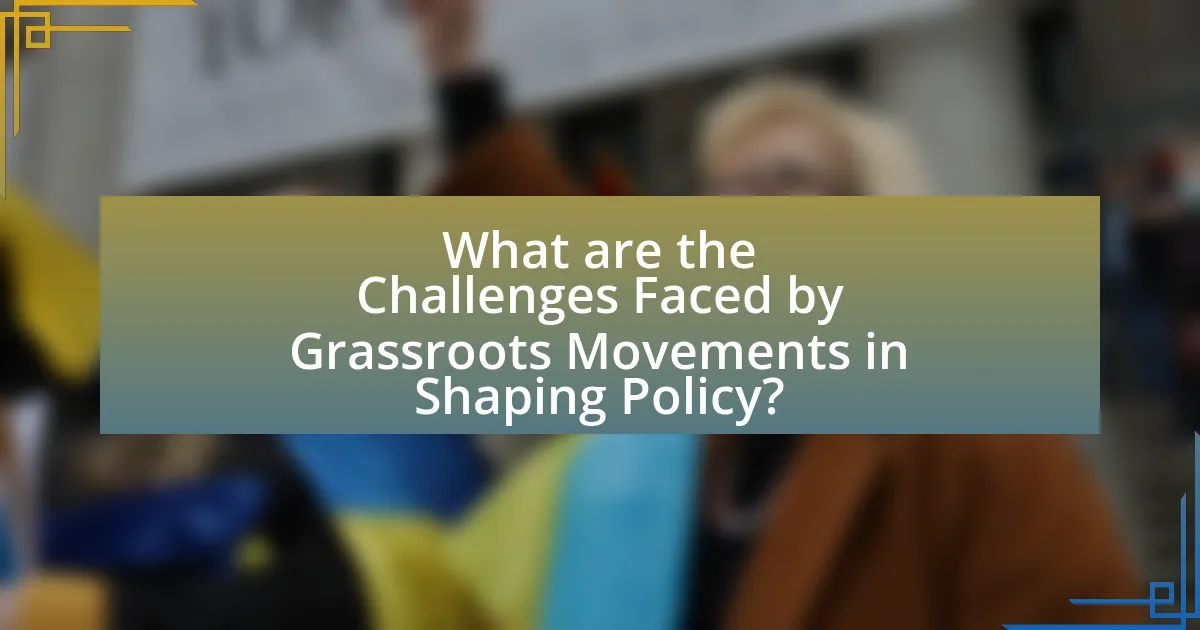
What are the Challenges Faced by Grassroots Movements in Shaping Policy?
Grassroots movements face several challenges in shaping policy, including limited resources, lack of access to decision-makers, and internal divisions. Limited resources hinder their ability to mobilize effectively and sustain campaigns, as many grassroots organizations operate on tight budgets and rely on volunteer support. Additionally, grassroots movements often struggle to gain direct access to policymakers, who may prioritize the interests of established lobbying groups over those of community-based initiatives. Internal divisions can also impede progress, as differing priorities and strategies among members may lead to conflicts that weaken the movement’s overall impact. These challenges collectively limit the effectiveness of grassroots movements in influencing policy outcomes.
What obstacles do Grassroots Movements encounter in their efforts?
Grassroots movements encounter several obstacles in their efforts, including limited funding, lack of media coverage, and opposition from established political entities. Limited funding restricts their ability to mobilize resources effectively, as many grassroots organizations operate on tight budgets and rely on small donations. Lack of media coverage hampers their visibility and public awareness, making it difficult to gain traction for their causes. Additionally, established political entities often resist grassroots initiatives, employing tactics such as lobbying or legal challenges to undermine their efforts. These challenges are evident in various movements, such as the Fight for $15 campaign, which has faced significant pushback from corporate interests and political opponents despite widespread public support.
How do funding limitations impact their activities?
Funding limitations significantly restrict grassroots movements’ activities by reducing their capacity to mobilize resources, conduct outreach, and sustain operations. When financial support is inadequate, these movements struggle to hire staff, organize events, and effectively communicate their messages, which diminishes their overall impact. For instance, a study by the National Committee for Responsive Philanthropy found that organizations with limited funding often face challenges in reaching broader audiences and influencing policy changes, as they lack the necessary tools and platforms to amplify their voices. Consequently, funding constraints can lead to diminished advocacy efforts and reduced effectiveness in driving social change.
What role does political opposition play in hindering their progress?
Political opposition significantly hinders the progress of grassroots movements by creating legislative and social barriers that obstruct their goals. For instance, when grassroots movements advocate for policy changes, political opposition can lead to the introduction of counter-legislation that undermines their initiatives, as seen in the fight for climate change policies where opposition parties often block or dilute proposed regulations. Additionally, political opposition can mobilize public sentiment against grassroots efforts, framing them as radical or unfeasible, which can diminish public support and reduce the movements’ effectiveness. This dynamic is evident in various historical contexts, such as the civil rights movement, where opposition from political leaders delayed significant legislative changes despite widespread grassroots advocacy.
How can Grassroots Movements overcome these challenges?
Grassroots movements can overcome challenges by building strong community networks and leveraging digital platforms for organization and outreach. These networks facilitate collaboration, resource sharing, and mobilization, which are essential for sustaining momentum and addressing obstacles. For instance, the Women’s March in 2017 effectively utilized social media to coordinate events and engage supporters, demonstrating the power of digital tools in amplifying grassroots efforts. Additionally, grassroots movements can focus on education and awareness campaigns to inform the public and policymakers about their causes, thereby increasing visibility and support. Research shows that movements with clear messaging and community involvement are more likely to influence policy changes, as seen in the successful advocacy for climate action by groups like Sunrise Movement.
What strategies can they implement to secure funding and resources?
Grassroots movements can implement several strategies to secure funding and resources, including building strong community networks, leveraging social media for crowdfunding, and establishing partnerships with local businesses and organizations. By fostering a sense of community and shared purpose, grassroots movements can attract donations and volunteer support, which are crucial for sustaining their initiatives. For instance, successful campaigns often utilize platforms like GoFundMe or Kickstarter to reach a wider audience, raising significant amounts of money; in 2020, crowdfunding platforms collectively raised over $34 billion globally. Additionally, forming alliances with local businesses can lead to sponsorships or in-kind donations, further enhancing resource availability. These strategies not only provide financial support but also increase visibility and engagement within the community, essential for driving policy changes.
How can they build resilience against political pushback?
Grassroots movements can build resilience against political pushback by fostering strong community engagement and establishing diverse coalitions. Engaging the community creates a sense of ownership and commitment, which can mobilize support during challenges. Diverse coalitions bring together various stakeholders, enhancing credibility and amplifying voices, making it harder for political entities to dismiss their concerns. For instance, the Women’s March in 2017 successfully united various groups, demonstrating that collective action can withstand political opposition. This approach not only strengthens the movement’s resolve but also increases its adaptability to changing political landscapes.
What practical steps can individuals take to support Grassroots Movements?
Individuals can support grassroots movements by actively participating in local initiatives, volunteering time, and donating resources. Engaging in community events, attending meetings, and spreading awareness through social media amplifies the movement’s message. Research indicates that grassroots movements can significantly influence policy changes; for example, the Black Lives Matter movement has led to legislative discussions on police reform in various states. By contributing to these efforts, individuals help create a collective impact that drives policy change.
How can community members get involved in local movements?
Community members can get involved in local movements by participating in grassroots organizing efforts, attending community meetings, and volunteering for local initiatives. Grassroots organizing allows individuals to collaborate with others who share similar goals, fostering a sense of community and collective action. Attending community meetings provides opportunities to voice concerns, share ideas, and learn about ongoing movements. Volunteering for local initiatives, such as clean-up drives or advocacy campaigns, directly contributes to the movement’s objectives and strengthens community ties. Research indicates that active participation in local movements can lead to significant policy changes, as seen in various successful campaigns across the United States.
What resources are available for those looking to advocate for policy change?
Resources available for those looking to advocate for policy change include advocacy organizations, online platforms, and educational materials. Advocacy organizations such as the American Civil Liberties Union (ACLU) and the Sierra Club provide tools, training, and support for grassroots movements. Online platforms like Change.org and Care2 enable individuals to create petitions and mobilize support for specific issues. Educational materials, including guides from the National Civic League and the Center for American Progress, offer insights into effective advocacy strategies and policy analysis. These resources collectively empower individuals and groups to influence policy effectively.










